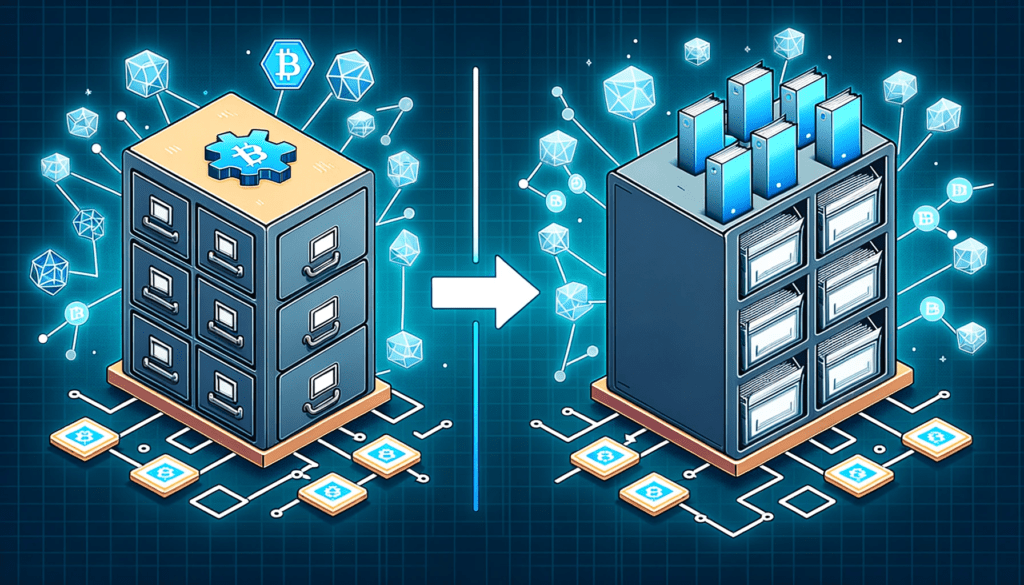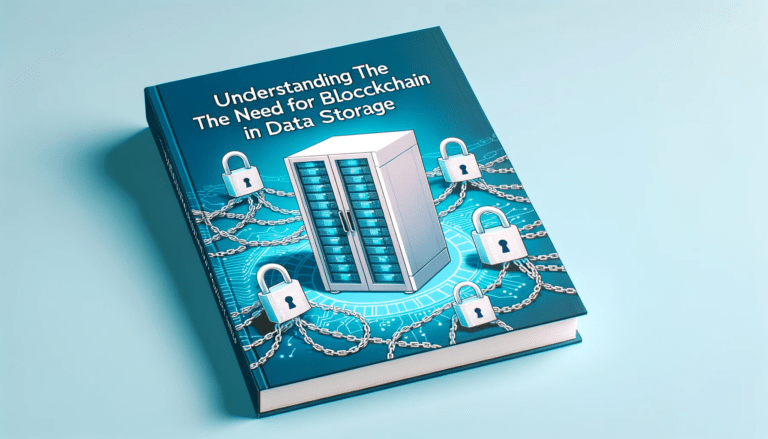In recent years, the paradigm of data storage has seen a shift, and this has a lot to do with how corporations and organizations have started using blockchain to store data. Blockchain, the disruptive technology behind cryptocurrency, is not just about digital transactions; it is now being used to revolutionize the way we store and manage data.
The application of blockchain to store data vows to boost the security and immutability of data, delivering a system that is resistant to tampering, revisions, or data loss. Owing largely to its decentralized nature, it paves the way for greater transparency and enables a more secure, reliable form of data storage. As we delve into the layers of this article, we will unravel more about how the intricate technology of blockchain is transforming the world of data storage.
Understanding the Need for Blockchain to store data
In the contemporary digital era, vast amounts of data are generated every day, leading to a consequential necessity for a secure, efficient, and reliable method of data storage. Decentralized data storage, facilitated by blockchain technology, presents an innovative solution to this growing demand. The architecture of this technology negates the need for a central authority for data management, providing a higher degree of security than traditional data storage mechanisms.
The appeal of decentralized data storage primarily lies in its ability to provide immutable, transparent, and verifiable data storage. Utilizing blockchain to store data increases trust and decreases the likelihood of data manipulation or loss. Moreover, it offers the assurance of storing data across multiple nodes, ensuring redundancy and robustness in the system. These attributes of blockchain potentially revolutionize how we perceive data storage and management, thus solidifying the need for blockchain in data storage.

Traditional Data Storage vs. Blockchain Data Storage
In the realm of traditional data storage, information is housed in centralized servers. This often presents issues relating to security, control, and accessibility. The data can be easily tampered with, lost, or accessed by unauthorized personnel due to the centralized nature. One of the key features traditional data storage lacks is immutability—the inability to change or alter data once it has been recorded, which leaves room for data inconsistencies and fraud.
Contrarily, when we use a blockchain to store data, it provides enhanced security through its decentralized, immutable structure. Immutability ensures that once data is recorded on the blockchain, it cannot be altered or removed. This makes blockchain data storage inherently more secure and reliable. Furthermore, it enables transparent data management with near real-time updates, increasing trust and reducing the potential for fraudulent activities. Additionally, blockchain enhances data accessibility and control by allowing users to access their information from any point in the network, all while maintaining privacy and security.
The Rise of Blockchain for Secure Data Management
Blockchain technology, once merely recognized for its role in cryptocurrency transactions, has evolved substantially to emerge as a leading solution for secure data management. The increasing rate of cyber crimes and data breaches has raised the need for innovative security solutions, and blockchain’s unique features, such as decentralization, immutability, and transparency, make it a strong contender in this race. The charge towards secure data management via blockchain has brought into focus concepts like on-chain and off-chain storage, which form the crux of data storage and management within the blockchain.
On-chain and off-chain storage are two predominant methods of data storage in the blockchain. On-chain storage refers to data that is stored directly on the blockchain and is publicly accessible to all participants in the blockchain network. This data is immutable and cryptographically secure. On the other hand, off-chain storage pertains to data stored outside the blockchain network, providing a scalable and efficient way to handle larger data sets. While on-chain and off-chain storage both have their own merits and demerits, their combination allows businesses to leverage blockchain to store data securely and efficiently.
Certainly! Here's the table in HTML format with the links hidden: ```html
| Fact/Figure Type | Description or Value | Source |
|---|---|---|
| Use Cases | Finance, gaming, real estate, supply chain management, and healthcare | Statista |
| Market Growth (2020 to 2024) | From US$4.5 billion in 2020 to an estimated US$19 billion by 2024 | Finder.com |
| Market Growth (2022 to 2029) | From $7.18 billion in 2022 to $163.83 billion in 2029 | Fortunly |
| Data Storage Method | Hashing (storing only the hash value of the data in the blockchain) | GeeksforGeeks |
| Industry Application (2023) | Manufacturing (Blockchain market size in manufacturing grew to $85.64 billion in 2023) | Findstack |
```
Core Concepts
Blockchain technology's ability to store data hinges on two fundamental concepts: cryptographic security and decentralization. Here, cryptographic security pertains to the usage of complex mathematical algorithms to encrypt data and safeguard it from online threats. This serves as a robust defense mechanism, ensuring that the data stored on the blockchain remains tamper-proof and secure from potential cyber-attacks.
On the flip side, the concept of decentralization is integral to how blockchain achieves reliable data storage. Instead of concentrating data storage in a single entity or location, blockchain disseminates the data across network participants or nodes. This distribution of information bolsters the robustness and reliability of blockchain to store data, negating the risk of single-point failures that could compromise the data's integrity. This unique blend of cryptographic security and decentralization is what makes blockchain an attractive option for secure data storage.

What Makes Blockchain Suitable for Data Storage?
The innovative nature of blockchain technology makes it a promising option for storing data. One of the primary reasons for this is the advent of Smart Contracts. Smart Contracts are self-executing contracts with the terms of agreement directly written into code. These contracts live on the blockchain, thus ensuring that they are decentralized, transparent, and immutable. This could transform how we manage data, making transactions traceable, transparent, and irreversible.
With blockchain, data is distributed across a network of computers, decreasing the likelihood of data loss or manipulation. This level of security amplifies the effectiveness of Smart Contracts, which rely on the integrity of the data they process. While traditional data storage solutions can be vulnerable to attacks, the blockchain is resistant to a single point of failure. Because any change to the data is noticeable and requires the consensus of the majority, attention is drawn to suspicious activity. This feature enhances the potential of the blockchain for secure data storage.
The Principle of Decentralization in Blockchain Data Storage
The principle of decentralization is a fundamental attribute of the blockchain protocol, radically altering how data storage is managed in comparison to traditional centralized systems. Unlike traditional systems, where data is stored on a centralized server under the control of a single entity, blockchain disperses data across numerous nodes on the network. This obviates the need for a trusted intermediary and ensures that not one entity holds the monopoly on information, thereby promoting a level of autonomy and security hitherto unattainable.
Implementing blockchain to store data presents numerous advantages. For instance, by using a blockchain protocol incorporating decentralization, data becomes immune to typical vulnerabilities such as server downtime or a single point of failure. Moreover, the use of blockchain to store data introduces a high degree of transparency and traceability, thanks to its public ledger system. In this way, every transaction recorded on the blockchain is visible to all network participants, establishing trust and accountability within the system.
Immutability: A Key Feature of Blockchain Data Storage
Immutability refers to the property of blockchain technology that once data has been written onto a blockchain, it cannot be altered or deleted. This unique characteristic of blockchain offers an unprecedented level of data privacy, since all transactions and data exchanges are transparent, but cannot be tampered with or manipulated. This leads to an enhanced trust in the security level of transactions, keeping data secure and private.
Furthermore, using blockchain to store data provides a robust solution to the age-old problem of data privacy in digital spaces. The immutability feature means that every entry registered on the blockchain is permanent. As such, using blockchain to store data offers the most secure method of storing sensitive information, as it prevents unauthorized editing or deletion. For anyone looking to ensure the highest level of data privacy, using blockchain to store data could be the answer. Through its strong and transparent nature, blockchain presents an effective and reliable method for data storage.

Technical Insights
Data encryption is a salient feature associated with the use of blockchain for data storage. It essentially involves converting data into a code to ensure unauthorized access is prevented. When data is stored on a blockchain, advanced encryption algorithms are used to encrypt the data, ensuring that it cannot be understood or compromised without the decryption key. This enhanced layer of security gives blockchain an edge over traditional forms of data storage technologies.
Moreover, blockchain technology’s inherent architecture design leverages a peer-to-peer network where each participant, or node, has access to the entire database, and its history shared across the network. The encrypted data points are then stored as blocks, and every block contains a hash, which is a unique identifier of the block. This further secures the data by enabling blockchain to provide a distributed and decentralized data storage environment, reducing the risk of single-point failures and hacks. However, the use of encryption also necessitates the need for robust key management strategies when using blockchain to store data.
On-chain and Off-chain Data Storage: What's the Difference?
In the Blockchain environment, there are two prominent models for storing data - on-chain and off-chain. The on-chain data storage follows a transaction model that involves storing data directly on the blockchain. The information gets securely inscribed onto the distributed ledger, which consequently extends the blockchain's capacity to store data robustly and securely. It's highly secure, transparent and allows everyone on the network to access the data stored on the blockchain.
Off-chain data storage, on the other hand, employs a different approach to data storage. The data in this model doesn't directly get recorded onto the blockchain; instead, it is stored through references or pointers on external storage devices. It is a well-suited model to store sizable amounts of data without congesting the main network. Off-chain storage process happens outside the blockchain yet leverages the security that blockchain has to offer, making data storage faster and efficient. The balance between these two methods essentially helps handle the flux of data efficiently within the blockchain.
| Feature | On-chain Data Storage | Off-chain Data Storage |
|---|---|---|
| Data Storage Location | Directly on the blockchain | Outside the blockchain (e.g., external databases) |
| Accessibility | Public (if on a public blockchain) | May be private or restricted |
| Data Integrity | High (immutable records) | Varies (depends on external system security) |
| Transaction Speed | Slower (due to consensus mechanisms) | Faster (no consensus required) |
| Scalability | Lower (limited by block size and network capacity) | Higher (not limited by blockchain constraints) |
| Cost | Higher (transaction fees, storage costs) | Lower (no blockchain transaction fees) |
| Data Privacy | Lower (data is publicly visible) | Higher (data can be kept private) |
| Data Retrieval | By transaction ID or block number | Custom retrieval methods |
| Dependency | Dependent on blockchain network | Independent of blockchain network |
| Use Case Scenarios | Asset ownership, Smart contracts | Scalable dApps, Off-chain computations, Data caches |
Storing Data on Blockchain: A Transactional Perspective
Data storage on a blockchain network is largely a transactional procedure, governed by the unique operational principles of blockchain technology. Unlike conventional digital data storage systems, every unit of data stored on a blockchain is treated as a transaction that needs to be confirmed and validated by the network before it's permanently recorded onto a block.
In the context of a blockchain network, storing a piece of data doesn't simply mean placing it in a digital 'box'. Instead, it implies meticulously crafting a transaction that encodes the data before broadcasting it to the system. Further, the rigorous consensus mechanism of a blockchain network ensures that these transactions (in this context, the data that is being stored) are incorruptible and easily verifiable, guaranteeing an unprecedented level of data integrity and security.

Protocols and Methods for Storing Data on Blockchain
One could regard the procedures to encode and decode information as protocols in the context of blockchain storage. Blockchain makes use of various protocols, depending on the nature of the data to be stored and the blockchain system itself. Several protocols such as Interplanetary File Systems (IPFS) and Storj offer advanced methodologies for blockchain-based data storage. Differentiation in methods and protocols occurs majorly due to how the blockchain nodes reach a consensus, how data is stored, and how the security and privacy of data are ensured. They prioritize factors like user privacy, security, scalability, and access to stored data as per their design and purpose.
Storing data on the blockchain involves a few necessary steps, including the verification and validation of data by nodes in the network, which is part of a method. This method follows a unique and secure manner of storing data such that the data once stored becomes immutable and tamper-proof, which is the backbone of blockchain technology. Also, relevant protocols dictate how data blocks are added to a chain, enunciating the methods used. Therefore, protocols and methods for storing data in the blockchain heavily influence how the complex web of nodes communicates, stores, and ensures the security of data. This culminates in blockchain's ability to function as a reliable and efficient system for data storage.
Limitations in Blockchain Data Storage: Size and Costs
While blockchain technology offers compelling advantages for securely storing data, it is not without its limitations. One significant constraint when using blockchain to store data relates to space and size. Traditional databases harness the capabilities of extensive servers to offer vast storage options. In contrast, every node in a blockchain network requires its own copy of the complete blockchain, thus limiting the overall storage space. The larger the blockchain, the more disk space required. Limited storage makes it challenging to use blockchain to store data on a large scale.
Cost efficiency is another area of concern when using blockchain for data storage. The process of adding blocks to the blockchain, also known as mining, consumes considerable energy, raising the associated costs. In fact, one of the most resource-intensive aspects associated with using blockchain to store data is the consensus mechanism, particularly proof-of-work used in networks like Bitcoin. This process involves solving complex mathematical problems to add new blocks, and the computational power required is both expensive and energy-intensive. Despite the high level of security and transparency that blockchain provides, these limitations could present financial and logistical barriers to widespread adoption.
FAQS
What are the needs for blockchain in data storage?
The main reasons for using blockchain in data storage include enhanced security, increased transparency, data decentralization, and immutability of stored data. Blockchain data storage also eliminates the need for third-party intermediaries and can reduce costs in the long run.
How does traditional data storage differ from blockchain data storage?
Traditional data storage is centralized, meaning all of the data is stored in a single location, while blockchain data storage is decentralized and distributed across multiple nodes. This makes blockchain data storage more secure and less susceptible to data loss or hacking.
What key principles make blockchain appropriate for data storage?
The principle of decentralization and the feature of immutability make blockchain suitable for data storage. Decentralization ensures that the data isn't stored in a single location and is therefore less susceptible to data loss or hacking. Immutability ensures that once data is written to the blockchain, it cannot be changed or tampered with.
What is the difference between on-chain and off-chain blockchain data storage?
On-chain blockchain data storage refers to data that is stored directly on the blockchain. This data is publicly visible and cannot be changed or removed. Off-chain data storage refers to data that is stored outside of the blockchain but can still be linked to and referenced by the blockchain.
What are the main limitations of blockchain data storage?
One major limitation of blockchain data storage is the size. The size of a blockchain is constantly increasing as more blocks are added, which can make it difficult to store and manage. This in turn can lead to increased costs in terms of both storage and computational power. Another limitation is the cost of transactions, as each entry on the blockchain incurs a transaction fee.
How are transactions managed in blockchain data storage?
In blockchain data storage, each piece of data is processed as a transaction. These transactions are grouped together to form blocks, which are then added to the blockchain. Every block has a unique code, known as a hash, that distinguishes it from every other block on the chain.
What protocols and methods are used for storing data on the blockchain?
Various protocols and methods can be used to store data on the blockchain. These can include direct on-chain storage, off-chain storage with on-chain references, distributed file systems, and decentralized databases. The best method or protocol to use can depend on the size and nature of the data being stored.





Pingback: Will Blockchain takeover the world? 8 sUPER FACTS YOU WANT TO KNOW - techlooters.com